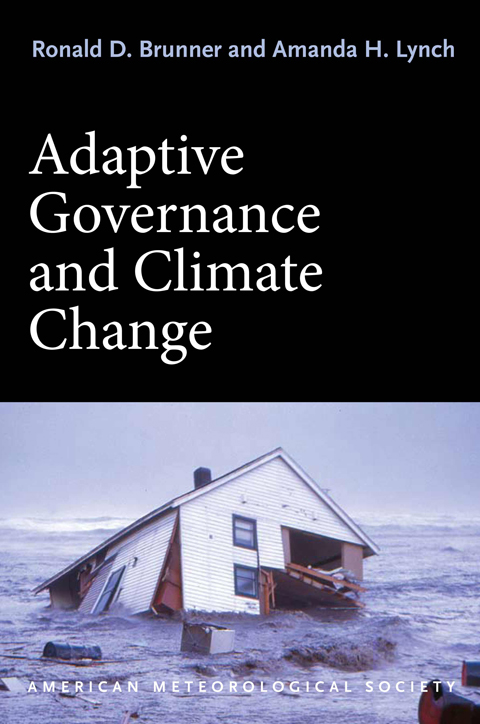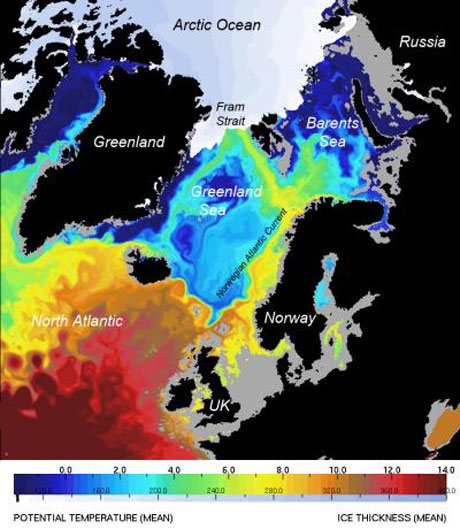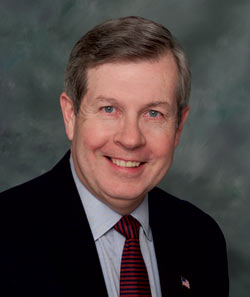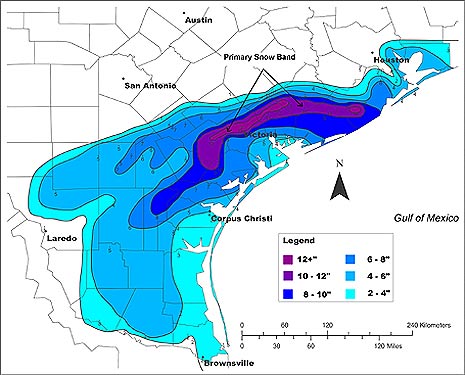UPDATE, 1/17/10: Due to a last-minute scheduling change, Amanda Lynch will be unable to attend the Annual Meeting. Adaptive Governance and Climate Change will still be a featured release at the AMS Book Launch Party on Monday.
The recent Copenhagen conference provided yet more evidence that countries with completely different priorities are often reluctant to enter into complex and costly agreements with each other. While international negotiations may seem cumbersome at best, some scholars argue that climate change may best be solved at the local–rather than international–level. Local action may not only be more effective but also could also someday might lead to international agreements.
This local-first policy approach will be explored in a variety of ways at the AMS Annual Meeting, headlined by the release of a new AMS book, Adaptive Governance and Climate Change, by Ronald Brunner and Amanda Lynch. Brunner and Lynch show how locally based programs foster the necessary diversity and innovation for climate adaptation.  Their book focuses on the real-life climate issues faced by Barrow, Alaska—and analyzes how the policies developed to address those issues could be adopted by other communities.
Their book focuses on the real-life climate issues faced by Barrow, Alaska—and analyzes how the policies developed to address those issues could be adopted by other communities.
In Atlanta, Lynch will be available to discuss these policy perspectives when the book is released as part of the AMS Book Launch Party (Monday, 5:30 p.m., exhibit hall B1, booth 146). In addition, she will be signing copies of the book on Monday and Wednesday (2:45–4:00 p.m., exhibit hall B2).
Communities across the world are moving toward adaptive governance, as can be seen in a number of presentations at the Annual Meeting. Nanteza Jamiat’s poster on “Adaptation Challenges to Climate Change Disasters in the Karamoja Cluster (Cattle Corridor) in Uganda” (at the student poster session, Sunday, 5:30–7:00 p.m., exhibit hall B2) addresses the interrelationship of climate change and agriculture in a country where both are a way of life for most of the population. Barry Smit’s presentation on “Traditional Knowledge and Adaptation to Climate Change in the Canadian Arctic” (Wednesday, 9:00–9:15 a.m, B213) focuses on indigenous people in the Arctic and the cultural barriers that sometimes need to be broken in order to implement local adaptation initiatives. The Pacific Island nation of Tuvalu is the subject of “Weathering the Waves: Climate Change, Politics, and Vulnerability in Tuvalu,” a poster by Heather Lazrus (Monday, 2:30–4:00 p.m., exhibit hall B2) that shows how one of the most vulnerable areas in the world is in some cases reverting to traditional governmental methods to meet the perils of climate change. And Cynthia Fowler’s presentation on “Coping in Kodi: Local Knowledge about and Responses to Climate Change and Variable Weather on Sumba (Eastern Indonesia)” (Tuesday, 4:15-4:30 p.m., B213) notes that many people in Indonesia’s marginal environments relate climate change to local development, thus crystallizing in one small area many of the problems that were evident at Copenhagen between developing and developed countries.
Uncategorized
Charting the Course of Arctic Warmth…and Oceanography
While many parts of the country have recently been experiencing conditions that residents might call “Arctic,” the Arctic region itself has been warming since at least the early 1990s, reaching warmth unprecedented in the last century. The consequences for global climate are potentially critical―particularly if fresh water from melting ice and increased atmospheric precipitation in the Arctic slow the overturning circulation of the North Atlantic. With Arctic sea ice melting dramatically in recent years, scientists are trying to understand the influence of the warmer water that flows into the Arctic from the North Atlantic.
At the National Oceanography Centre (NOCS) in Southampton, United Kingdom, scientists using high-resolution computer models found that from 1989 to 2009, about 50% of the salty North Atlantic water entering the Arctic Ocean came through Fram Strait, a deep channel between Greenland and the Norwegian island of Spitsbergen that connects the Nordic Seas to the Arctic Ocean. The Barents Sea contributes about as much Atlantic water to the Arctic, but the Fram Strait water carried most of the heat that has been a primary cause of Arctic ice melting.
An example of the modeling in this study, published in the January 2010 issue of Journal of Marine Systems, can be seen in the image below, which shows a computer simulation of ocean temperatures at a depth of 100 meters and sea ice thickness in September 2006. The pathways of warm saline water toward the Arctic have previously been poorly understood, but here the 8-km resolution defines three distinct pathways for this water to move under the more pure Arctic water, thus pumping heat northward between 50 and 170 meters below the surface.
“Computers are now powerful enough to run multidecadal global simulations at high resolution,” said NOCS scientist Yevgeny Aksenov. “This helps to understand how the ocean is changing and to plan observational programs so as to make measurements at sea more efficient.”
Ocean-climate interactions are a primary focus of the ocean science research priorities recommended by the U.S. National Science and Technology Council’s Joint Subcommittee on Ocean Science and Technology (JSOST) in their 2007 report, “Charting the Course for Ocean Science in the United States for the Next Decade: An Ocean Research Priorities Plan and Implementation Strategy.” As our understanding continues to evolve regarding the ocean and its influence on the Earth system, the priorities outlined in this report have also evolved. A town hall meeting on “Refreshing Our Ocean Research Priorities” (Monday, 12:15–1:15 p.m., B212) at the upcoming AMS Annual Meeting will explore some of these developments and give participants a forum to discuss topics of interest with the chairs of JSOST.

This Christmas, the Gift of Salience
Midwesterners take pride in their ability to handle blizzards and ice that make walking and driving miserable and harrowing, not to mention downright dangerous. Even so, yesterday, people generally stayed off the roads, canceling long awaited Christmas Eve events. Those who ventured out often ran into trouble, according to news reports:
Betsy Graupe lost count of the number of vehicles she saw in the ditch while driving from Chicago to see her family in Minneapolis, a journey of some 350 miles (570 kilometers).
“It was very, very bad out,” said Graupe, who ended up pulling off the highway and spending Wednesday night in a hotel.
“It was poor visibility, and icy and the road was rutted… it was quite an adventure.”
Were the people who spun out beside the road lacking experience with winter? Were they unaware of the situation? Were they making a bad calculation of the risks, or just unlucky?

We’ll probably never know unless some enterprising social scientist follows up. Scientists did follow up on one recent storm—the miserable icing in January 2007 that turned roads into skating rinks in the nation’s midsection during the AMS Annual Meeting in San Antonio.
If you remember, hundreds of attendees never made it to that meeting due to airport and road closures. Kim Klockow and Randy Peppler of the University of Oklahoma polled their peers about travel to that meeting. Their findings, presented at the 2008 AMS Annual Meeting (and published this summer in the NCAR newsletter, Weather and Society Watch), show that very few of their cohorts chose to stay home. Some avoided hopeless airline delays by choosing to drive despite road conditions. Some were anxious about the trip from Norman to San Antonio, some were not. Many left early, others left late, but they found ways to deal with the weather, minimizing but not eliminating travel risks. Access to information gave them enough confidence to brave the situation and make relatively bold choices.
Of course, these were weather savvy travelers—“weather salient,” in the psychological lexicon (see this BAMS paper by Alan E. Stewart for more on this). One wonders how seasoned natives navigated similar choices yesterday and today.
In Oklahoma, at least, the governor didn’t wait long to see what people would do. He closed interstates and state highways:
“I am urging all Oklahomans to take winter storm precautions and stay off the roads unless travel is absolutely necessary,” Gov. Brad Henry said earlier in the day after declaring a state of emergency. “This is a very serious winter storm, and we want Oklahomans to stay safe.”
Perhaps the governor didn’t read Klockow and Peppler’s study. Or maybe he did, and realized that the bar for weather salience this Christmas was a little too high.
Author, Sailor, Scientist, AMS President-to-Be
“I’ve been trying to keep this to the scientific side tonight, Amy,” Mike said. “But you can tell this has been more of a spiritual experience, for me.”–from Seraphim Sky, by Jonathan Malay (iUniverse, 2003)
It’s not every day that we get to quote from a novel, but then, with the

results from this fall’s AMS elections announced today, we’re understandably going to stray from the scientific side and get into the spirit of the moment.
Seraphim Sky is not just any book, but a novel by our newly announced AMS President-Elect Jon Malay, a one-time research oceanographer, astronaut candidate, and meteorological officer for the Navy, more recently an entrepreneur, government manager, and long-time proponent and practitioner of space-based observational programs, now at Lockheed-Martin.
Undoubtedly, we’ll have more in this blog later about his ideas for 2011, when he takes over leadership of our Society from incoming president, Margaret LeMone. Already in BAMS he’s emphasized the commitment the United States must maintain in geophysical observations and services, as well as the breadth of AMS and its impact:
We in the AMS have a collective responsibility to do whatever we can to ensure that policy decisions are based on sound science and reasoned judgment. The economic consequences of actions taken by the U.S. government (and, for that matter, governments around the world) will have enormous consequences—either for good or for very, very, bad. What stands between these two extremes is the effectiveness of the educated and technically correct voice of the AMS community.
Congratulations to Jon and to the four newly-elected AMS Councilors, Ken Carey, John Schaake, Rick Spinrad, and Ahsha Tribble. Now back to the (mostly) scientific side.
Have Your Cake and Communicate Better, Too
UPDATE, 1/16/10: Due to a last-minute change, David Schultz will not be able to attend the Annual Meeting and participate in the events discussed in this post. The AMS book launch party will be held as scheduled on Monday.
In the modern world of text messages, Tweets, and, yes, blogs, it’s easy for the craft of writing to be overlooked for the sake of immediacy, shock value, or just plain laziness. Indeed, time for eloquence increasingly seems like a luxury as technology makes communication more convenient and commonplace.
Thankfully, there are still defenders of the art; one of them, the University of Helsinki’s David Schultz, chief editor of Monthly Weather Review, has recently written a book
Magic Numbers
The tangibility of numbers makes them an ideal tool for marketing. Telling drivers to slow down isn’t nearly as vivid as telling them that “55 saves lives,” (though we later learned that 65 m.p.h. apparently saves lives just as well). Football fans have probably seen ads for the NFL’s “Play 60” campaign that encourages children to get a daily hour of exercise, and there is a similar program for K-5 teachers and their students called “Take 10.” Numerous other examples abound.
Not surprisingly, climate change activists have discovered the allure of numbers, too. A recent worldwide demonstration highlighted
Taking a Dive in the Maldives
In the final days before the U.N. Climate Change Conference in Copenhagen, the intensity of rhetoric has been unrelenting. Inevitably, the science that got us to this moment takes a back seat: the world’s policymaking apparatus is now steering.
The people who feel the most helpless in this process are not scientists, though. They may very well be politicians. Or at least, that’s what the government of the Republic of Maldives, desperately wants us to know. Living at an average elevation of just 5 feet, their population has every reason to be concerned about projections of sea-level rise.
So, if you’re slated to be the next Atlantis, what better place to take a stand about helplessness than underwater? The Maldives’ president and his Cabinet donned scuba gear

in October and communicated 16 feet beneath the ocean’s surface using hand gestures during a protest of the U.N climate summit in Copenhagen, which the Maldives claimed was too expensive to attend. During the underwater meeting, the Cabinet signed a declaration calling for global cuts in CO2 emissions, to be presented at the Copenhagen meeting.
An Inconvenient Snow
Next week on Friday (11 December), 7 p.m. Central Time, the University of Texas-Austin will present a live Webcast of “Global Warming—Lone Star Impacts,” a lecture by Gerald North ofTexas A&M.
It should be an interesting occasion, not just because North is an experienced scientist and climate change is a hot topic, but also because of the timing. The lecture was supposed to be delivered this past Friday, yet an unseasonable snowstorm got in the way. Ah, the inconvenient truths of climate: day-to-day weather can be uncooperative.
As SciGuy blogger Eric Berger for the Houston Chronicle observes: “What does snow falling in Houston have to do with global warming? Nothing. Nada. Zip.” For emphasis, Berger also posted a great photo from a record Houston snowfall in 1895, not to be missed by history buffs.
Friday’s storm across the Gulf Coast delivered the earliest snow on record for Houston–but just five years ago the region had a Christmas snowfall with depths of up to 13 inches.
Fortunately this week’s snow was lighter, but if you’re interested in a detailed perspective about how Gulf coast snow mechanisms can be surprisingly prolific and yet quite “ordinary”, check out the poster by Ronald Morales presented at the 2007 AMS Conference on Mesoscale Processes. It’s full of vivid satellite and radar imagery from the 2004 storm, as well as this overview of the snowfall.
